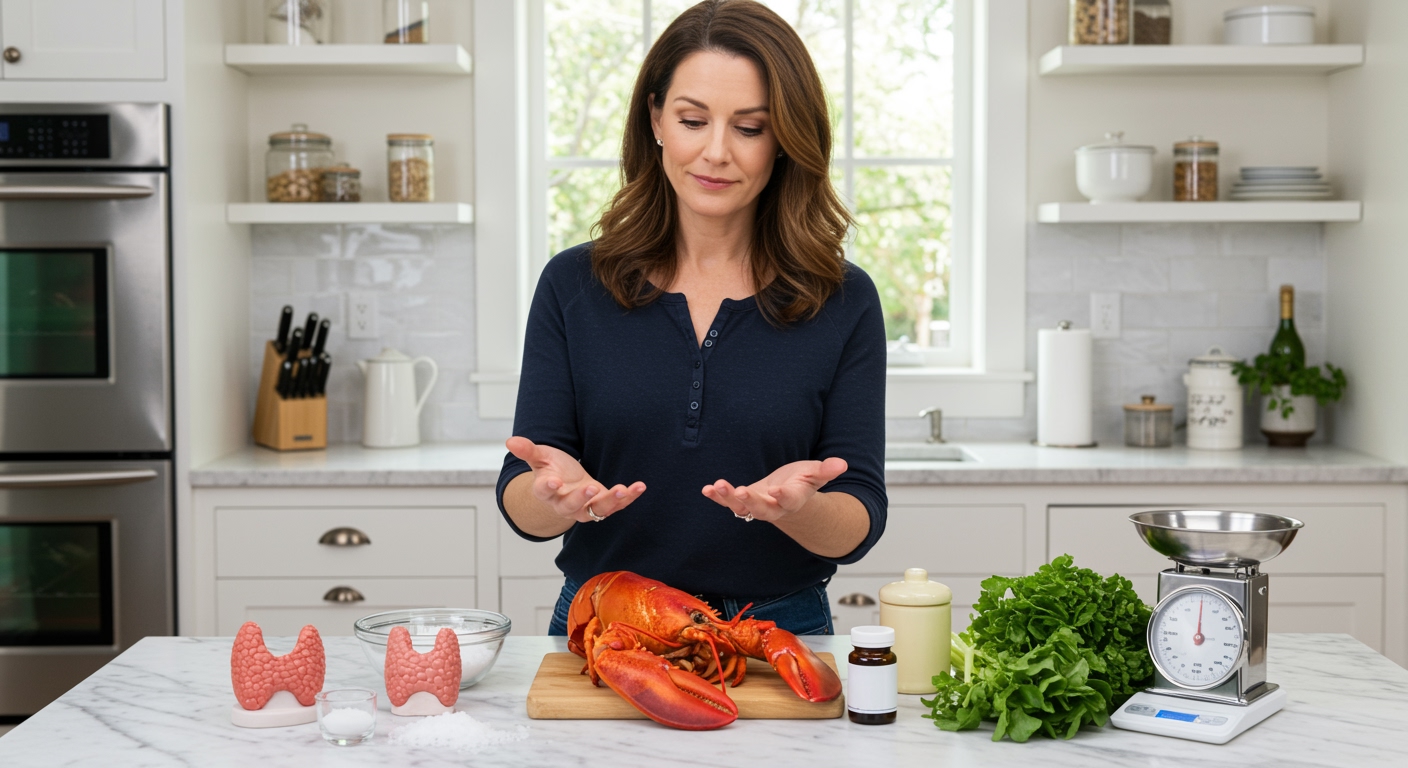✪ Key Takeaway: Lobster can support hypothyroidism through selenium and protein but requires careful iodine monitoring to avoid thyroid complications.
Introduction
You walk past the seafood section and see fresh lobster on display.
Your mind immediately asks whether this expensive delicacy will help or harm your struggling thyroid.
You might be asking this question because you have heard conflicting information about seafood and thyroid health, or perhaps your doctor mentioned watching your iodine intake but never explained which foods to choose.
The confusion makes sense because seafood contains nutrients that both support and potentially complicate thyroid function.
Hi, I am Abdur, your nutrition coach and today I am going to explain exactly how lobster affects your thyroid, which nutrients matter most, and whether you should include it in your hypothyroidism diet.
What Nutrients Does Lobster Provide For Thyroid Function?
Lobster delivers several nutrients that your thyroid needs to produce hormones properly.
A 100-gram serving of cooked lobster contains approximately 36 micrograms of selenium, which represents about 65 percent of your daily requirement.
Selenium plays a critical role in converting the inactive thyroid hormone T4 into the active form T3 through enzymes called deiodinases.
Without adequate selenium, your body cannot efficiently use the thyroid hormones it produces, even if your thyroid gland itself functions normally.
Lobster also provides high-quality protein with about 20 grams per 100-gram serving, which supports overall metabolic function.
The zinc content in lobster, roughly 3 milligrams per serving, contributes to thyroid hormone synthesis and immune system regulation.
Additionally, lobster contains vitamin B12, which many people with hypothyroidism lack due to reduced stomach acid production and impaired nutrient absorption.
✪ Fact: Selenium deficiency can reduce thyroid hormone production by up to 40 percent even when iodine intake is adequate.
How Does Iodine In Lobster Impact Your Thyroid?
The iodine content in lobster creates the most significant consideration for people with hypothyroidism.
A 100-gram serving of lobster contains approximately 100 micrograms of iodine, which represents about 67 percent of the recommended daily intake.
Your thyroid gland uses iodine as the primary building block for thyroid hormones, combining it with the amino acid tyrosine to create T4 and T3.
However, the relationship between iodine and hypothyroidism is not straightforward.
If your hypothyroidism stems from iodine deficiency, which is rare in developed countries with iodized salt, then lobster can provide beneficial iodine.
But if your hypothyroidism results from Hashimoto thyroiditis, an autoimmune condition affecting about 90 percent of hypothyroidism cases in iodine-sufficient areas, excessive iodine intake can worsen thyroid inflammation.
Research shows that high iodine intake can trigger or exacerbate autoimmune thyroid attacks by increasing thyroid peroxidase antibodies and causing oxidative stress within thyroid cells.
✪ Note: Always check your thyroid antibody levels before increasing iodine-rich foods like lobster in your diet.
Can Lobster Help With Hypothyroidism Symptoms?
Lobster can address several nutritional deficiencies that worsen hypothyroidism symptoms.
The high protein content helps combat the muscle weakness and fatigue that many people with hypothyroidism experience daily.
Protein supports muscle maintenance and provides sustained energy without causing blood sugar spikes that can worsen fatigue.
The selenium in lobster may help reduce thyroid inflammation and improve the conversion of T4 to T3, potentially alleviating symptoms like brain fog, cold intolerance, and low energy.
Studies demonstrate that selenium supplementation in people with autoimmune thyroid disease can reduce antibody levels and improve overall wellbeing.
Lobster is also low in calories and fat, containing only about 90 calories and less than 1 gram of fat per 100-gram serving.
This nutrient profile makes it an excellent choice for people with hypothyroidism who struggle with weight management due to their slower metabolism.
✪ Pro Tip: Pair lobster with non-starchy vegetables to create a satisfying meal that supports thyroid function without excess calories.
What Are The Risks Of Eating Lobster With Hypothyroidism?
The primary risk comes from consuming too much iodine if you have autoimmune hypothyroidism.
Eating lobster multiple times per week alongside other iodine-rich foods like seaweed, dairy products, and iodized salt can push your total iodine intake above safe levels.
Excessive iodine intake can cause a phenomenon called the Wolff-Chaikoff effect, where your thyroid temporarily shuts down hormone production to protect itself from iodine overload.
In people with Hashimoto thyroiditis, high iodine intake can increase thyroid antibodies and accelerate thyroid tissue destruction.
Another consideration is the cholesterol content in lobster, which provides about 70 milligrams per 100-gram serving.
While dietary cholesterol has less impact on blood cholesterol than previously thought, people with hypothyroidism often have elevated cholesterol levels due to reduced liver clearance.
Lobster also contains purines that break down into uric acid, which could be problematic if you have gout or kidney issues alongside your thyroid condition.
✪ Note: Mercury contamination is minimal in lobster compared to large predatory fish, making it a safer seafood choice.
How Often Should You Eat Lobster With Hypothyroidism?
The ideal frequency depends on your specific type of hypothyroidism and overall iodine intake.
If you have non-autoimmune hypothyroidism or iodine deficiency, eating lobster once or twice per week provides beneficial nutrients without excessive iodine.
This frequency allows you to enjoy the selenium, protein, and other nutrients while maintaining balanced iodine levels.
For people with Hashimoto thyroiditis, limiting lobster to once per week or every two weeks makes more sense.
You should also monitor your total daily iodine intake from all sources, aiming to stay between 150 and 300 micrograms per day.
Pay attention to how your body responds after eating lobster by tracking symptoms like fatigue, brain fog, or changes in your thyroid medication needs.
Working with your doctor to test thyroid antibody levels periodically can help you determine whether your current lobster consumption supports or harms your thyroid health.
✪ Pro Tip: Keep a food and symptom journal to identify your personal tolerance for iodine-rich foods like lobster.
The Bottom Line
Lobster can be a valuable addition to your hypothyroidism diet when consumed in appropriate amounts based on your specific thyroid condition.
The key to thyroid health is not avoiding foods but understanding how your unique body responds to them, and lobster offers enough benefits to warrant occasional inclusion for most people with hypothyroidism.
I would love to hear about your experience with seafood and thyroid health, so please share your thoughts, questions, or personal stories in the comment section below.
References
At NutritionCrown, we use quality and credible sources to ensure our content is accurate and trustworthy. Below are the sources referenced in writing this article:
- Healthline: Lobster Nutrition: Is It Healthy?
- Thyroid Pharmacist: Iodine and Hashimoto’s
- Frontiers in Endocrinology: Iodine and Hashimoto’s Thyroiditis
- Mayo Clinic: Hypothyroidism (underactive thyroid)
- National Institute of Diabetes and Digestive and Kidney Diseases: Hypothyroidism (Underactive Thyroid)





